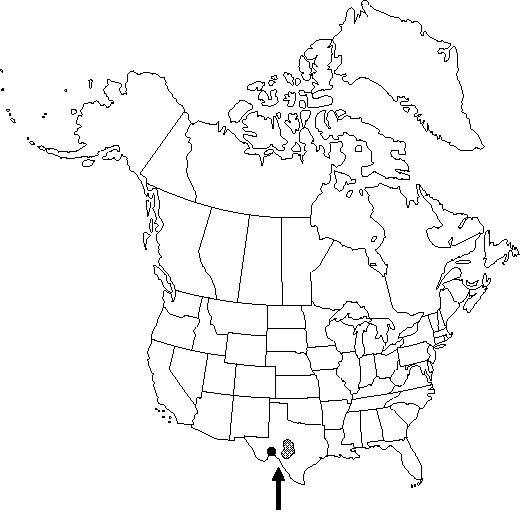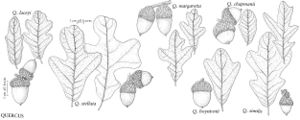Quercus laceyi
Bull. Torrey Bot. Club 28: 358. 1901.
Trees, deciduous, to 5-8(-10) m. Bark light colored, papery or scaly. Twigs gray, 1.5-2 mm diam., pubescent with erect stellate hairs, these soon shed, at maturity reddish and pruinose to tan and glabrous. Buds brown, ovoid to ovoid-lanceoloid, 1.5-3 × 1-2 mm, apex acute, glabrous. Leaves: petiole (3-)5-9(-12) mm. Leaf blade blue-green, glaucous, obovate or elliptic, (20-)40-90(-210) × (20-)30-60(-110) mm, thin, base cuneate and decurrent on petiole to rounded or rarely somewhat cordate, margins thin, flat, entire to shallowly lobed or (rarely in shade forms) deeply lobed, lobes if present oblong, squarish, often retuse, secondary veins 6-9 on each side, each terminating in tooth or arching near margins, apex broadly rounded, retuse; surfaces abaxially whitish, with erect stellate hairs, hairs shed as leaves expand, becoming glabrous, glaucous, adaxially glabrous, glaucous. Acorns annual, solitary or paired, subsessile or on short peduncle to 10(-20) mm in leaf axil; cup saucer-shaped or shallowly cup-shaped, 4-7 mm deep × 10-12(-18) mm wide, enclosing 1/3 nut or less, scales moderately tuberculate, finely tomentose; nut oblong or barrel-shaped, often flattened at both ends, (11-)13-15(-20) × 9-11(-14) mm. Cotyledons distinct.
Phenology: Flowering in spring.
Habitat: Limestone hills, woodlands and riparian forests, canyons and streamsides
Elevation: 350-2200 m
Distribution

Tex., Mexico (Coahuila and Nuevo León).
Discussion
Material from Texas and northeastern Mexico, excluding the type, has been incorrectly referred to Quercus glaucoides M. Martens & Galeotti by some authors (K. C. Nixon and C. H. Muller 1992).
On the Edwards Plateau of Texas, Quercus laceyi occurs mostly at 350-600 m elevation; in Coahuila and Nuevo León, it occurs at 1500-2200 m. This species is sometimes associated with remnant mesic forests, which include Acer grandidentatum Nuttall, Tilia species, Quercus muhlenbergii Engelmann, and various pine and other oak species. The leaves are shallowly lobed or entire, although occasional specimens on moist sites are deeply lobed and resemble the leaves of Q. alba in outline.
